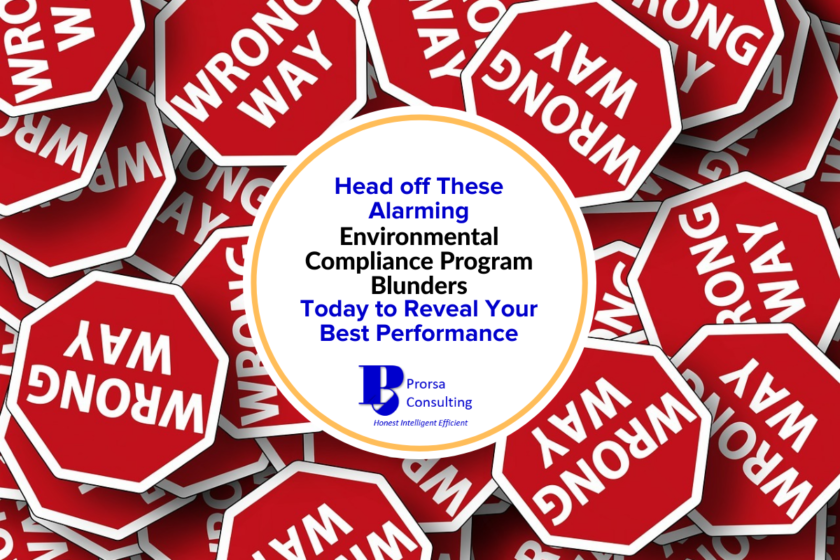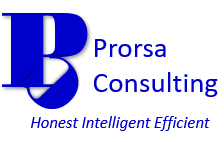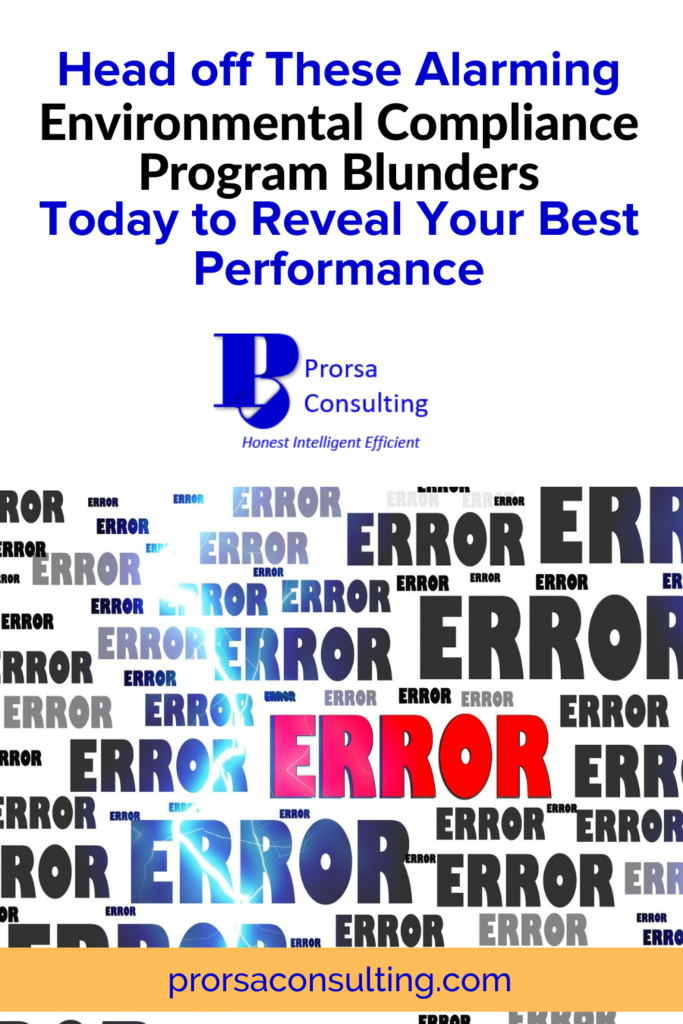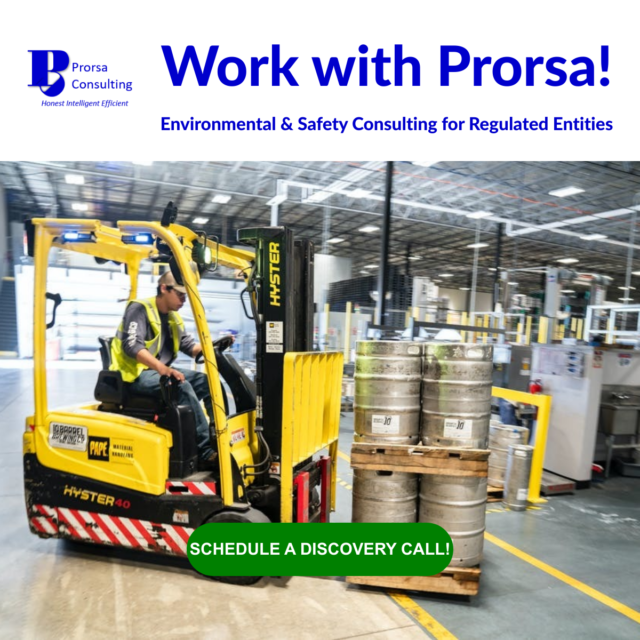Head off These Alarming Environmental Compliance Program Blunders Today to Reveal Your Best Performance
By : Admin -

Environmental compliance program blunders leave businesses open to increased risk.
This risk can take more than one form. It could show itself as increasing non-compliance, leading to fines and penalties. Alternatively, a company’s reputation may suffer, causing reduced customer confidence and fewer sales. Last but not least, organizations leaving their environmental compliance program blunders unchecked could jeopardize the environment.
With these scenarios as possible outcomes, shouldn’t your company strive to sidestep EHS compliance mistakes before they occur?
Being informed, having a plan, and enacting systems can effectively mitigate the most common compliance failures. So, let’s take a closer look at some frequent offenders and the sensible strategies to control them.
Misunderstanding environmental requirements sets the stage for a compliance failure.
Why? Environmental laws, rules, and permits can be challenging to comprehend, especially for untrained or inexperienced persons.
The extensive nature of these standards can easily overwhelm. The requirements’ language can also make them hard to follow. Furthermore, solid understanding frequently requires cross-referencing other regulations, laws, or support materials.
Even highly knowledgeable environmental professionals sometimes find it tricky to discern legal obligations. One individual may interpret an essential item one way while another understands that same item oppositely.
Leaders must ensure that those with environmental compliance responsibilities have the proper awareness, training, and experience to comprehend and successfully execute required tasks fully.
Training plays a pivotal role in building effective compliance programs. Yet, the education provided to key environmental personnel cannot be a simple one and done. Every individual deserves an opportunity to refresh their knowledge, especially in the intricate world of environment and regulatory compliance in business.
Additionally, companies should strive to hire individuals with solid academic backgrounds and strong regulatory experience when environmental leadership positions become available. Likewise, organizations should avail themselves of environmental compliance consulting to understand requirements when necessary.

Image by Jon Anders Wiken at https://stock.adobe.com.
Don’t create EHS compliance mistakes by neglecting to stay on top of rule changes.
The environmental regulatory climate is constantly changing, making it easy to commit environmental compliance blunders.
Updates to rules can and do happen. Thus, regulatory requirements often change over time as technology and information improve. Legal mandates evolve like most other things in life.
Furthermore, guidance documents, policies, and courts’ interpretations may change. What a regulator or court deems compliant today may not be so five years from now. The fluidity of the regulatory climate heightens non-compliance risk when businesses don’t stay informed of updates.
Staying abreast of changes is necessary to ensure effective compliance programs that meet all legal requirements.
Countless ways exist to keep current with changing rules applicable to your company. Agencies and consulting firms usually sponsor webinars to alert regulated entities when wide-reaching rule changes occur. Additionally, blog posts, newsletters, and news releases from regulators and subject matter experts can provide relevant information on regulatory updates.
Trade associations will frequently cover industry-specific changes to environmental rules for their members. Listservs like the Federal Register Table of Contents and regulatory subscription services like RegUpdate.BLR.com will send emails to your inbox to keep you alerted and up to date.
Nevertheless, no one-size-fits-all approach exists concerning updates associated with the environment and regulatory compliance in business. Regardless of the methods utilized to stay current on applicable rules, each organization should ensure it receives and assesses changes to environmental requirements regularly to avoid EHS compliance mistakes.

Image by stokkete at https://stock.adobe.com.
Missing regulatory submittals or submitting items late are common environmental compliance program blunders.
When submitting required reports to regulatory agencies, inferior performance can prompt a laser focus on an organization.
Forgotten, late, and incomplete environmental submissions are some of the most straightforward compliance violations to spot for an agency. Either the regulated entity provided an on-time, complete submittal or did not. Written documents are like video . . . they are hard to dispute.
Yet, the secondary consequence of regulatory submittal mistakes may open your operations to greater risk. When a company gets simple compliance reporting wrong, it can create suspicion with the regulator about whether the company is meeting its other environmental requirements. Suddenly, the agency could be taking a deeper look at the business to investigate.
Companies should properly track and manage environmental submittals to avoid preventable environmental compliance program blunders associated with missed deadlines and inaccurate data.
Wise organizations use task management tools to notify responsible persons and track the progress of their compliance reporting efforts. You should consider the following options if your program does not already have a system in place:
- Action Item Matrix (AIM) – Teams can quickly build this tool in Microsoft Excel or Google Sheets. Just be sure to store the AIM in a shared folder so all who need to can access it for necessary updates.
- Online Task Managers – Platforms like Asana and Click-Up can accommodate team collaboration and automatically send email reminders for regulatory deadlines and status updates on submission tasks.
- Microsoft Outlook + notification add-ons – Another in-house, budget-friendly solution involves creating a shared calendar in Outlook and using an add-on, like SendLater, for notifications. An individual populates the environmental reporting tasks in the Outlook calendar, shares the calendar with affected team members, and drafts email notifications on a custom schedule for upcoming calendar events using the add-on.
Furthermore, workers who prepare environmental submissions must engage the business’s authorized officials for review and final release to the agency. These company officials usually sign the submitted documents, so they are on the hook if anything goes wrong.
Preparers should discuss the report’s information with authorized officials to ensure the identification and correction of any errors before sending final documents to regulators. Also, authorized officials may need a reminder to retain confirmations of all submittals as part of the facility’s environmental records.
Not having the proper permits can swiftly become a costly environmental misstep.
Companies do not usually have the legal authority to emit or discharge pollutants into the environment without a permit.
Environmental permits spell out the requirements to operate in a manner that protects the environment. A facility’s permit will also provide a list of activities the site will need to undertake to demonstrate its compliance.
Operating without legal authority is another item that is relatively easy to prove. Like the compliance reporting discussed in the previous section, either the site obtained a permit, or it didn’t. Moreover, ignorance will not provide an acceptable defense.
To avoid environmental compliance program blunders, organizations should have experienced staff in-house or hire a knowledgeable environmental compliance consulting firm to assist with permitting efforts.
Environmental permitting can be a very complex task. Even minor changes to an operation’s process may require additional authorization from the regulatory agency.
So, companies should discuss applicability with in-house or external subject matter experts before adding or modifying processes, products, or chemicals at a facility. Those responsible for environmental oversight need to be highly involved during the planning phases to have the information necessary to seek and obtain any necessary permits on behalf of the facility.
Poorly implemented corrective actions do not add value to environmental compliance programs.
When businesses identify compliance challenges, they must resolve those issues promptly.
Failing to implement proper corrective actions adds insult to injury. An uncorrected violation only makes the operation more vulnerable to citations and penalties. Additionally, it is more likely that a neighbor or an employee may file a complaint when the facility leaves an issue unaddressed for an extended period.
Additionally, not acting to correct violations found during a regulatory inspection can put a site at heightened risk of being shut down. Losing the right to operate could detrimentally impact the organization’s bottom line for days, months, or even permanently.
Ensure follow-ups to any inspection, audit, or program review include corrective action planning.
It is not enough to only identify items of concern during environmental checks. Companies must also plan and implement steps to correct deficiencies. Some may be simple to fix. However, others will take more thorough planning and resource allocation to reattain compliance.
Environmental personnel should work with supervisors and managers to verify corrective action task assignments to the proper responsible persons. Likewise, schedule regular status reports to keep all involved in the loop. Alternatively, businesses can take advantage of electronic solutions to help with status notifications and the management of corrective actions.

Image by chuttersnap at https://unsplash.com.
Learn to sidestep the environmental compliance failure of inadequate equipment maintenance.
Keeping equipment in tip-top shape is key to avoiding these types of environmental compliance program blunders.
You cannot make a widget if your widget-maker does not work. Similarly, you will not correctly capture or treat your pollution if your collectors or treatment systems fail to function as they should. This situation not only puts the environment at risk but may also affect the efficiency of the operation.
Numerous pieces of equipment may exist at a facility, and any one of them may have the potential to create a compliance concern. So, the importance of proper maintenance should not be ignored or discounted because the possible effects on the environment and regulatory compliance in business could be dire.
A robust system that identifies, corrects, and prevents equipment issues will improve environmental compliance.
Companies should glean potential maintenance issues from regular inspections, audits, incident investigations, and other examinations. Finding problems before they escalate will save money and effort.
Moreover, effective compliance programs will benefit from a system that employees can use to report equipment concerns as they occur. Reporting to the supervisor or notifying maintenance directly allows for the swift correction of non-compliant conditions.
Furthermore, you will want to close the loop on equipment maintenance by efficiently managing tasks. Utilize a maintenance management system if you have one to make assigning and tracking these tasks more systematic.
Also, ensure the business develops a plan for preventative maintenance. Keeping your equipment at its best operational capacity decreases the chances of failures in the future.
Related Environmental Compliance Program Blunders Posts
Universal Waste Fundamentals and Practical Tips to Help You Say Never Again to Noncompliance
Reduce Risk and Instantly Master Your Stormwater Compliance with 5 Essential Strategies
16 Quick Items for a Timesaving Environmental Walkthrough Inspection
EHS Compliance Benefits to Know and Always Welcome in Your Operations
End Thoughts
Companies cannot afford a misstep when dealing with the environment and regulatory compliance in business. Your company can prevent the most common environmental compliance program blunders with proper knowledge, planning, and execution.
We encourage your feedback on this blog. Be sure to like, comment, and share below if you enjoyed the content. You can also provide us with feedback via our Contact Us page.
Don’t forget to follow Prorsa Consulting on LinkedIn, Pinterest, and Twitter.
Prorsa Consulting works with regulated businesses to assess, maintain, and improve environmental and safety compliance to lower business risk. Schedule a discovery call today to get started down the path to better compliance.
How would you like access to additional, exclusive EHS updates and info from Prorsa Consulting? Just signup for the Prorsa Consulting Newsletter below. You’ll be able to unlock our Free Resources area and all its tools, templates, and presentations. Get your free subscription today!





